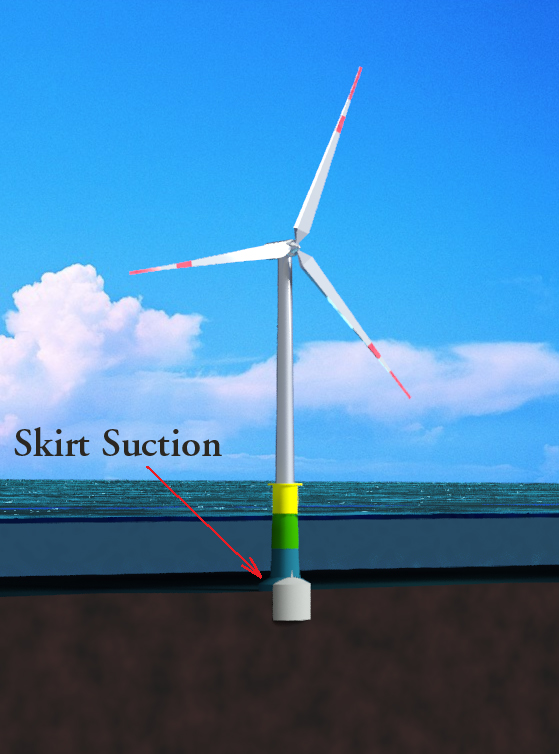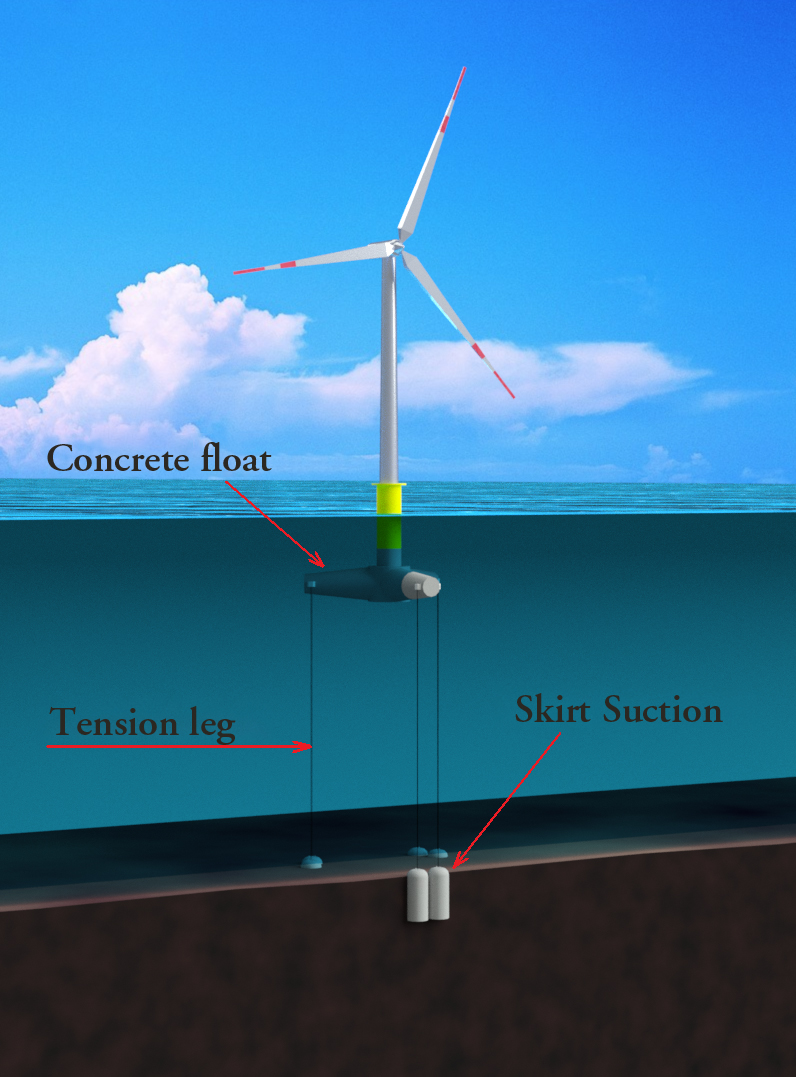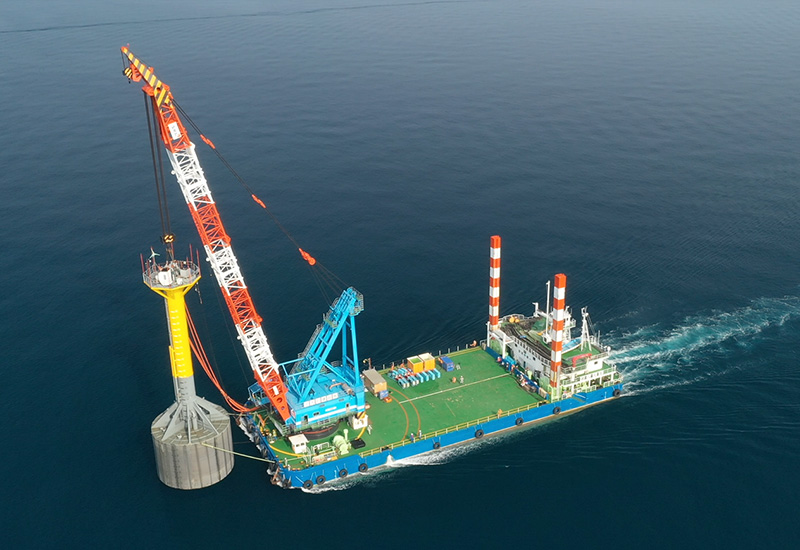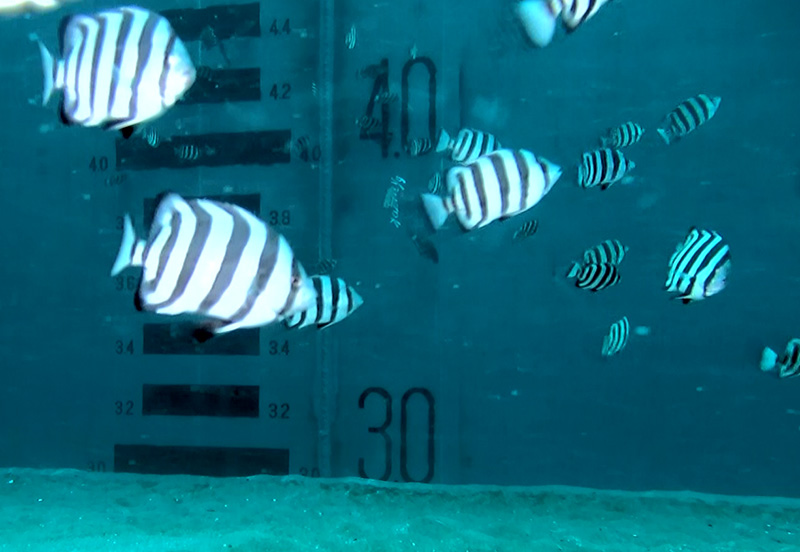- 4 Technology
- Technology Development
Offshore Wind Power Using Two Construction Technologies: Fixed Type and Floating Type
We have established two construction technologies, fixed type and floating type, for offshore wind power
Demonstration of installation and removal of full-scale Skirt Suction® in the fixed type
Obayashi Corporation has established technologies pertaining to offshore wind turbine construction in two forms: the fixed type and floating type.
Partly due to the fact that the Act on the Utilization of Sea Areas for Renewable Energy came into force in April 2019, demand for the construction of offshore wind turbines is forecast to gain momentum going forward. For example, a spate of plans to develop offshore wind power are expected in regions throughout Japan. The structural forms of wind turbines can be divided into the fixed type for which the columns of the wind turbine reach the seabed, and floating type for which the wind turbine itself floats on the ocean. The fixed type is suitable in the case that the water depth is comparatively shallow and the floating type is suitable in the case that the water is deep.
Obayashi Corporation is advancing the development of offshore wind turbine construction technologies adapted to each of these forms, and we have demonstrated the suitability of the fixed type as an offshore wind turbine foundation by actually installing and removing the full-scale Skirt Suction offshore. Furthermore, regarding the floating type, we have devised the "TLP Type of Floating Offshore Wind Turbine Unit" which tautly moors the concrete float to the seabed, and have acquired approval in principle from Nippon Kaiji Kyokai (ClassNK).


-
Demonstration of the installation and removal of a full-scale suction foundation, the first in Japan

Offshore Skirt Suction installation The Skirt Suction which we installed and removed on this occasion has a total height of 33 m, skirt length of 8 m, and skirt diameter of 12 m, and was installed in the sea at a water depth of 13 m. Approximately two weeks after the installation, we measured the wave force acting on the foundation and the stress and displacement, angle of inclination, etc. of the foundation. After finishing the measurements, we completely removed the foundation using water injected inside the skirt, thereby demonstrating the suitability of Skirt Suction as an offshore wind turbine foundation. There have been previous examples of construction of foundations penetrated into a seabed using water pressure (suction foundations), but this was the first time in Japan that a full-scale foundation that could be the foundation of an offshore wind turbine was installed and removed offshore where it was affected by actual ocean waves. Note that this technology has acquired the Examination and Certification of New Coastal Technologies developed by Private Companies from the Engineering Coastal Development Institute of Technology.

Injected water removal status -
Acquisition of approval in principle for a floating type offshore wind power facility adopting Skirt Suction
The tension leg platform type for mooring the float is comprised of the float, the tension leg for tautly mooring the float to the seabed (fixing of the float structure on the seabed using the tensioning force generated by the surplus buoyancy), and the anchor for fixing the tension leg to the seabed. It has the advantages that the occupied area of the sea is small compared to the catenary form so its impact on organisms is reduced, only a small amount of mooring materials are required, and the shaking of the offshore wind turbines is small so power generation efficiency becomes higher, etc.
Obayashi Corporation has devised a "TLP Type of Floating Offshore Wind Turbine Unit" adopting Skirt Suction for the anchor, and now we have acquired an AIP (Approval In Principle) approving the fact that design of said facility is possible if certain conditions are stipulated from Nippon Kaiji Kyokai. Because we have acquired the AIP, the floating type offshore wind turbines with a tension leg platform have taken one step toward realization and away from the desktop investigation stage that they have been in until now.
Abbreviated name for the Act on Promoting the Utilization of Sea Areas for the Development of Marine Renewable Energy Power Generation Facilities (Act No. 89 of 2018).
Comprised of the top slab and the cylindrical vertical wall (the skirt) leading down from the top slab, this is penetrated into the seabed using the suction (the pressure of the inside of the skirt becoming lower than the hydrostatic pressure) that occurs due to dewatering from inside the skirt. The large machinery used to place monopile and jacket piles, which are fixed, is not necessary, so construction of the foundations without vibrations or noise is possible.
The form that attaches a long chain to the float to maintain the float with a shape bent into the shape of Mt. Fuji’s ridge line by the chain’s own weight. Generally, the chain is installed so that it spreads in three directions or four directions, so it occupies a wide area of the seabed.
- Management and
Organization- The Articles of Incorporation
- Basic Principles
- Transitioning of Corporate Symbol
- Corporate Officers
- Organization Chart
- Stock Information
- Financial Statements
- Technology
- BIM Timeline
- Awards
- Major Publication
- Group Companies
- Group Companies (in Japan)
- Group Companies (Overseas)